Willem van Herp the Elder (c. 1614 – 1677) stands as a notable figure in the rich tapestry of 17th-century Flemish Baroque painting. Active primarily in Antwerp, the bustling artistic hub of the Southern Netherlands, van Herp carved a niche for himself through his prolific output of religious subjects, often rendered on a small scale, and engaging genre scenes. While he operated somewhat in the shadow of colossal figures like Peter Paul Rubens and Anthony van Dyck, van Herp's artistry demonstrates a keen understanding of their innovations, which he skillfully adapted to his own distinct purposes, creating works that found considerable favor both locally and internationally, particularly in the Spanish markets.
Early Life and Artistic Formation in Antwerp
Born in Antwerp around 1614, Willem van Herp emerged into a city that was a crucible of artistic talent and innovation. The precise details of his earliest training are somewhat sparse, a common challenge when reconstructing the lives of artists from this period who were not of the absolute first rank. However, records indicate that between 1625 and 1629, he was apprenticed to two lesser-known masters: Damiaan Wordelmans (sometimes spelled Woutelmans) and later Hans Biermans. While these figures may not be household names today, their tutelage would have provided van Herp with a solid grounding in the fundamental techniques of painting prevalent in Antwerp at the time.
It is often speculated that van Herp may have had direct contact with the studio of Peter Paul Rubens, or at least spent considerable time studying his works. While concrete documentary proof of a formal apprenticeship under Rubens is lacking, the profound influence of the great master is undeniable in van Herp's compositions, figure types, and dynamic energy. It is more likely that van Herp, like many of his contemporaries, absorbed Rubens's style through careful observation, copying, and adaptation of his widely circulated paintings and prints. The artistic environment of Antwerp was so saturated with Rubens's influence that it was virtually impossible for any aspiring painter to remain untouched by his monumental legacy.
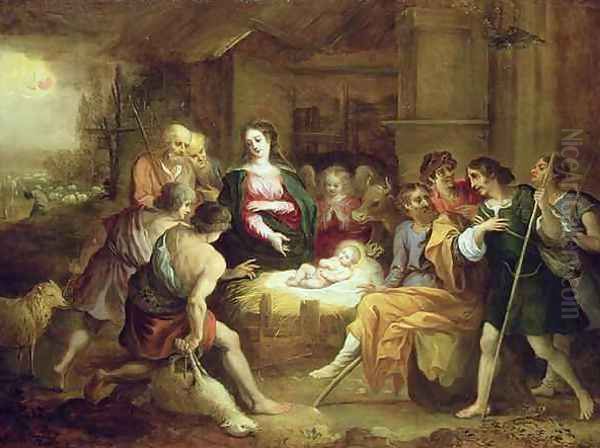
There is also some suggestion that van Herp may have traveled abroad for a period, possibly to further his artistic education or to seek patronage. Such journeys were not uncommon for ambitious Flemish artists. However, the specifics of any such travels remain unconfirmed. What is certain is that by 1637-1638, he was established enough to be registered as an independent master in the Antwerp Guild of Saint Luke, a crucial step for any artist wishing to practice professionally, take on pupils, and sell their work openly in the city. His marriage to Maria, the daughter of the painter Wouter Wolfs (a pupil of Artus Wolffort, another artist working in a Rubenesque vein), further integrated him into the artistic community. Two of their sons, Norbertus van Herp and Willem van Herp the Younger, would also follow in their father's footsteps and become painters.
Artistic Style: A Synthesis of Influences
Willem van Herp's artistic style is characterized by its synthesis of various prevailing trends in Flemish Baroque art, most notably the grandeur of Rubens and the intimate, detailed genre painting popularized by artists like David Teniers the Younger and Adriaen Brouwer. He demonstrated a remarkable versatility, adept at both religious narratives and scenes of everyday peasant life.
The Rubenesque influence is evident in his often dynamic compositions, the fleshy rendering of his figures, and a rich, warm palette. Van Herp frequently borrowed motifs and even entire compositional structures from Rubens, reinterpreting them on a smaller scale. This practice of creating pastiches or variations on the themes of more famous masters was common and catered to a market eager for works in the style of renowned artists but at more accessible prices. Artists like Cornelis Schut and Gerard Seghers also navigated this space, adapting Rubenesque and Caravaggist influences respectively.
From David Teniers the Younger, and perhaps Adriaen Brouwer, van Herp adopted a penchant for genre scenes, particularly depictions of peasant life, tavern interiors, and village festivities. These works are often characterized by lively groups of figures, expressive gestures, and a keen observation of social interactions. However, even in these genre pieces, van Herp's figures often retain a certain robustness that harks back to Rubens, distinguishing them from the sometimes more caricatured or delicate figures of Teniers.
A significant portion of van Herp's output consists of small-scale cabinet paintings, frequently executed on copper. This support material was favored for its smooth surface, which allowed for a high degree of detail and a luminous quality of color. The meticulousness required for painting on copper suited van Herp's careful technique and his ability to render intricate details in costumes, settings, and facial expressions. This preference for smaller, detailed works also aligned him with other Antwerp painters specializing in cabinet pieces, such as Frans Francken the Younger and Gonzales Coques, the latter known as the "little Van Dyck" for his small-scale elegant portraits and conversation pieces.
Thematic Focus: Devotion and Daily Life
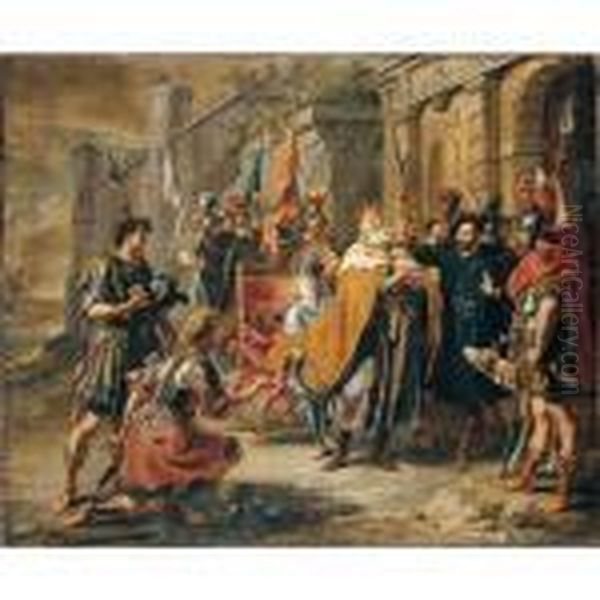
Willem van Herp's oeuvre can be broadly categorized into religious paintings and genre scenes, with occasional forays into mythological subjects. His religious works formed a substantial part of his production and were clearly in high demand. These often depicted scenes from the Old and New Testaments, as well as the lives of saints. Popular subjects included the Adoration of the Magi, the Holy Family, the Parable of the Prodigal Son, and scenes from the Passion of Christ.
His religious paintings were particularly well-suited for private devotion, being of a manageable size for domestic interiors or private chapels. They combined narrative clarity with a palpable sense of piety, often imbued with the dramatic intensity characteristic of the Baroque. Works like The Adoration of the Shepherds or Christ Healing the Sick showcase his ability to manage multiple figures within a coherent and emotionally resonant composition. The influence of earlier masters like Hendrick van Balen, who often collaborated with Jan Brueghel the Elder on small-scale mythological and religious scenes, can also be discerned in the tradition of finely wrought cabinet pictures.
In the realm of genre painting, van Herp excelled at capturing the boisterous energy of peasant life. Revelers in a Tavern, for instance, is a typical theme, allowing him to depict a range of human emotions and interactions, from merry-making to drunken stupors. These scenes, while often humorous, also provided a moralizing commentary on human behavior, a common subtext in 17th-century genre painting. His depictions of kermesses (village fairs) or peasants feasting and dancing are filled with anecdotal detail and a sense of earthy vitality. These works found a ready market among the burgeoning middle class, who appreciated their lively subject matter and relatable themes. The legacy of Pieter Bruegel the Elder, though a generation removed, still resonated in the popularity of such peasant scenes, further developed by artists like Brouwer and Teniers.
Key Works and Signature Pieces
While a definitive catalogue raisonné of Willem van Herp's work is complicated by the sheer volume of his output and the prevalence of studio participation and copies, several works are consistently attributed to him and exemplify his style.
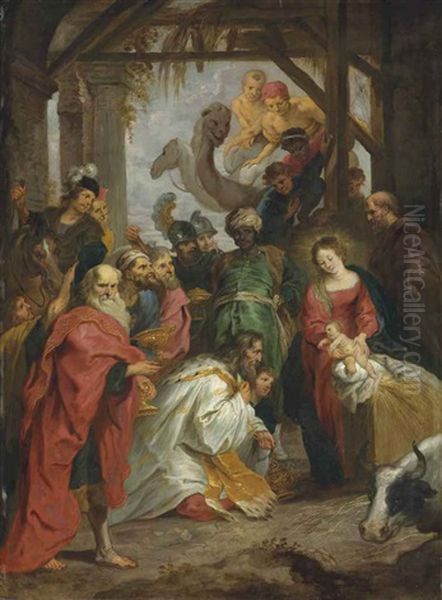
One of his most recognized religious paintings is Saint Anthony of Padua Distributing Bread (also sometimes titled A Franciscan Monk Distributing Bread or similar variations). This composition, of which several versions exist, depicts the popular saint engaged in an act of charity, surrounded by a crowd of eager recipients. The scene is rendered with van Herp's characteristic attention to individual expressions and gestures, creating a lively and compassionate narrative. The warmth of the colors and the dynamic grouping of figures are hallmarks of his approach to religious storytelling.
Another notable work, showcasing a different facet of his talent, is The Punishment of the Traitor. This painting, likely depicting a historical or mythological scene of justice being meted out, demonstrates his ability to handle more dramatic and complex narratives. The composition is typically filled with figures, each playing a role in the unfolding drama, and the scene is imbued with a sense of gravitas.
His genre scenes, such as Peasants Feasting and Dancing outside an Inn or various Tavern Scenes, are numerous and consistently display his skill in capturing the rustic charm and uninhibited behavior of rural folk. These works are often characterized by a crowded canvas, with multiple small groups of figures engaged in different activities, contributing to an overall sense of bustling activity. The influence of David Teniers the Younger is particularly apparent in these compositions, though van Herp's figures tend to be somewhat more robust and less refined than those of Teniers.
Many of his works are simply titled Biblical Scene or refer to specific parables like The Parable of the Sower or The Rich Man and Lazarus, indicating a broad engagement with scriptural narratives. These were often produced in series or as individual pieces for devotional use.
Collaborations and Workshop Practices
Collaboration was a cornerstone of the Antwerp art world in the 17th century, allowing artists to specialize and increase productivity. Willem van Herp was actively involved in such collaborative ventures. He is known to have frequently painted the staffage (figures) in the landscapes of other artists. Notable among his collaborators in this regard was Jacques d’Arthois, a leading landscape painter of the Brussels school whose expansive, wooded scenes often required the addition of lively figures to animate them. Van Herp's skill in rendering small, expressive figures made him an ideal partner for d'Arthois.
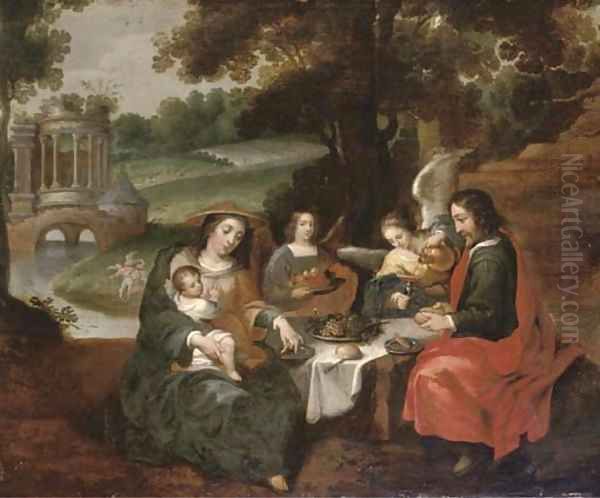
He also collaborated with architectural painters like Dirck van Delen, who specialized in intricate church interiors and palace courtyards. Van Herp would populate these meticulously rendered spaces with appropriate figures, adding narrative interest and a human scale to the architectural settings. Similarly, he is recorded as having provided staffage for Isaac van Oostens, another painter of landscapes and garden scenes.
A particularly significant collaborative relationship was with the prominent Antwerp art dealer Matthijs Musson. Musson played a crucial role in the marketing and distribution of van Herp's works, especially to the lucrative Spanish market. It is documented that van Herp not only sold his original compositions through Musson but also undertook commissions to repair and create copies or pastiches of works by more famous masters, particularly Peter Paul Rubens. This practice was not seen as deceptive at the time but rather as a way of disseminating popular compositions and meeting the demand for works in the style of celebrated artists. Musson's extensive network ensured that van Herp's paintings reached a wide audience, contributing to his international reputation.
Further evidence of his collaborative spirit is seen in his participation in larger projects, such as the series of designs for tapestries depicting the life of the Moncada family. For this ambitious undertaking, van Herp worked alongside other esteemed artists, including David Teniers the Younger, Adam Frans van der Meulen (a specialist in battle scenes and landscapes who later became court painter to Louis XIV), and Luigi Primo (also known as Louis Cousin), an Italian-born painter active in Brussels. Such projects highlight van Herp's standing within the artistic community and his ability to contribute effectively to complex, multi-artist endeavors.
The International Market: Spain and Beyond
A distinctive feature of Willem van Herp's career was the remarkable success his works enjoyed in Spain and, by extension, in the Spanish colonies in Latin America. This was largely facilitated by art dealers like Matthijs Musson and the Forchondt family firm, who had established extensive trade routes and catered to Spanish tastes.
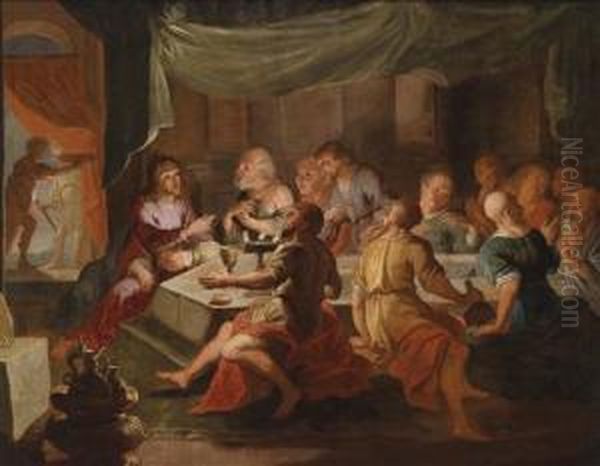
Van Herp's small-scale religious paintings, often on copper, were particularly popular. Their portability, detailed execution, and devotional subject matter appealed to Spanish patrons, both ecclesiastical and private. The themes he depicted – scenes from the life of Christ, the Virgin Mary, and popular saints – resonated strongly with the fervent Catholic piety prevalent in Spain during the Counter-Reformation. The influence of Rubens, whose works were also highly prized in Spain (Rubens himself having visited the Spanish court), likely added to the appeal of van Herp's Rubenesque compositions.
The sheer number of van Herp's paintings found in Spanish collections, both historical and contemporary, attests to this strong market connection. His style, which combined Flemish technical skill with emotionally accessible religious narratives, proved to be a successful formula for export. This international demand undoubtedly contributed to the prolific nature of his workshop, which likely produced numerous versions and variations of his most popular compositions to meet the ongoing orders.
Legacy and Challenges in Scholarship
Willem van Herp the Elder left behind a substantial body of work that reflects the artistic vitality of 17th-century Antwerp. He was a skilled and versatile painter who successfully navigated the competitive art market of his time by adapting the innovations of leading masters to his own strengths, particularly in the realm of small-scale religious and genre painting. His ability to create appealing compositions, often imbued with a warm palette and lively figures, ensured his popularity during his lifetime and beyond, especially in international markets.
Despite his productivity and contemporary success, van Herp's artistic career is not as extensively documented as those of some of his more famous peers. This scarcity of detailed records, combined with the common workshop practices of the era (including the production of replicas and variations, and unsigned collaborative works), makes the precise attribution and dating of his paintings sometimes challenging. The stylistic evolution of his work is consequently difficult to trace with certainty. Many works are attributed to him based on stylistic characteristics rather than definitive documentation, leading to a somewhat fluid and occasionally debated oeuvre.
Nevertheless, his contribution to the Flemish Baroque tradition is significant. He played a role in popularizing certain religious themes and genre motifs, and his works provide valuable insight into the tastes and devotional practices of the period. His collaborations with other artists underscore the interconnectedness of the Antwerp art scene, while his international success highlights the city's role as a major exporter of art. Artists like Theodoor Rombouts, known for his Caravaggesque genre scenes, also contributed to this vibrant artistic export market.
Willem van Herp the Elder remains an important figure for understanding the breadth and depth of painting in 17th-century Antwerp. He was a master of the cabinet picture, a skilled narrator of both sacred stories and everyday life, and an artist whose works found appreciation far beyond the borders of Flanders, leaving a lasting mark on the visual culture of the Baroque era. His legacy is that of a diligent and talented painter who, while perhaps not an innovator on the scale of Rubens or Van Dyck, skillfully synthesized the dominant artistic currents of his time into a distinctive and appealing body of work.